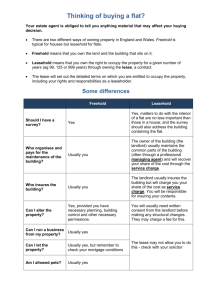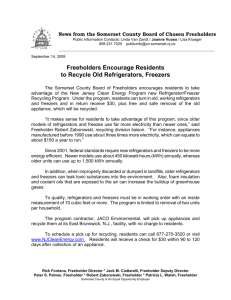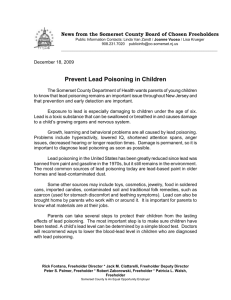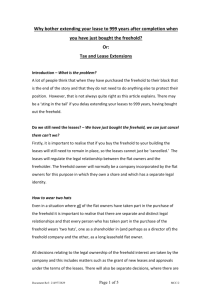guidance notes on buying your freehold as a
advertisement
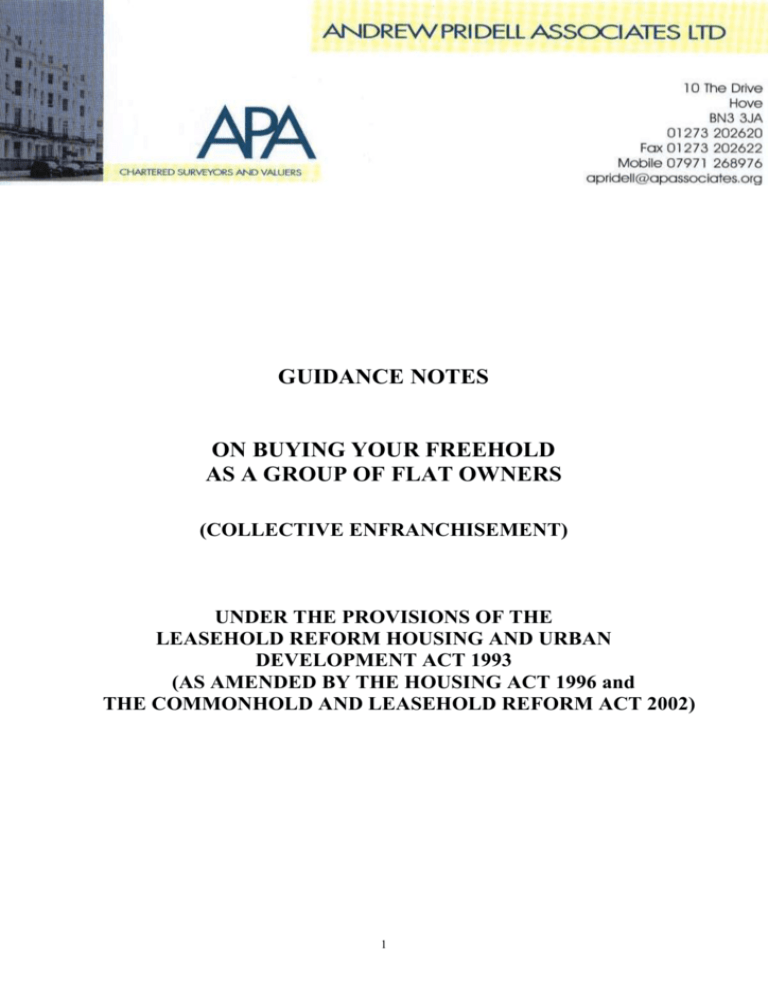
GUIDANCE NOTES ON BUYING YOUR FREEHOLD AS A GROUP OF FLAT OWNERS (COLLECTIVE ENFRANCHISEMENT) UNDER THE PROVISIONS OF THE LEASEHOLD REFORM HOUSING AND URBAN DEVELOPMENT ACT 1993 (AS AMENDED BY THE HOUSING ACT 1996 and THE COMMONHOLD AND LEASEHOLD REFORM ACT 2002) 1 CONTENTS Page no. 1. COMPANY PROFILE 3 2. CURRENT SITUATION 4 3. THE RIGHTS UNDER THE ACT 4 4. WHAT HAPPENS AFTER THE FREEHOLD HAS BEEN BOUGHT 5 5. PRICE 6 6. FREQUENTLY ASKED QUESTIONS 9 7. ADVANTAGES AND DISADVANTAGES 10 2 1. COMPANY PROFILE 1.1 Andrew Pridell Associates Limited is a company of Chartered Surveyors and Valuers, specialising almost exclusively in providing advice and valuations for lease extensions and collective enfranchisements, under the leasehold reform legislation. 1.2 Since the enactment of the 1993 Leasehold Reform Housing and Urban Development Act (as amended by the Housing Act 1996 and the Commonhold and Leasehold Reform Act 2002) the company has undertaken a large number of valuations, both for lessees and freeholders, under this legislation. 1.3 Andrew Pridell, Chairman, is a Fellow of the Royal Institution of Chartered Surveyors, having qualified as an Associate in 1969 and been elected to Fellowship in 1982. He qualified in the Building Surveying Division and had the honour of being an Examination County prize winner and subsequently transferred to the General Section. 1.4 Andrew Pridell joined the partnership of Clifford Dann and Partners, (now Clifford Dann LLP) in1972 and was a partner from 1983, most latterly Senior Partner. The practice is an independent firm of Chartered Surveyors, with its head office in Lewes, East Sussex. In addition to the professional departments, there are commercial and residential agency offices covering principally East and Central Sussex. 1.5 Andrew Pridell resigned his membership of Clifford Dann LLP in 2004 to establish Andrew Pridell Associates Limited, but remains a Consultant with Clifford Dann LLP with specific responsibility for professional residential valuation work. 1.6 The company has completed in excess of 4500 cases. These have been predominantly in the South East of England, including London, both in the prime Central area and in the suburbs, and geographically the spread of the cases has been as far North as Harrogate, East to Broadstairs and the Medway towns, and as far West as Cardiff. 1.7 Andrew Pridell has appeared at numerous Leasehold Valuation Tribunal hearings as advocate and expert and he has acted as expert witness in matters of litigation over many years and has given evidence at numerous Court hearings and Tribunals, including collective enfranchisement and lease extension appeal hearings in the Upper Tribunal (Lands Tribunal). 1.8 He regularly lectures on the subject of leasehold reform valuation and procedure to kindred professionals and conducts University seminars. 1.9 The company is a founder member of ALEP – the Association of Leasehold Enfranchisement Practitioners and Andrew Pridell is a Director. 1.10 Andrew Pridell is part of the Royal Institution of Chartered Surveyors Working Group on enfranchisement valuation. 1.11 Andrew Pridell .is an RICS Registered Valuer. 1.12 Andrew Pridell is an Honorary Consultant to the Federation of Private Residents’ Associations. 3 CURRENT SITUATION 1. Flat owners (lessees) (or the law calls you ‘tenants’) own their flats i.e. the bricks and mortar. 2. The freeholder (the law calls him ‘the landlord’) owns the land and is responsible for insuring and maintaining the structure of the building. The lessees are responsible for maintaining the interiors of the flats. 3. Flats are held on contracts known as ‘leases’ which are for a fixed term. In a typical case, this could be for 99 years from say 1972 – therefore the lease expires in 2071. 4. The lessees pay to the freeholder rent for the ground and this often escalates on the 33rd or 25th year anniversaries of the lease. A typical example could be : 1972 – 1997 1997 – 2022 2022 – 2047 2047 – 2071 5. £ 50 per annum £ 75 per annum £100 per annum £150 per annum At the expiration of the lease, the flats revert to the freeholder ; in other words, he gets the flats back – the current lessees remaining in as ‘rent paying tenants’. This is why the freeholder is referred to as “the reversioner” and the lessees are “the reversionees”. THE RIGHTS UNDER THE ACT 1. The 1993 Leasehold Reform Housing and Urban Development Act (as amended by the 1996 Housing Act and the Commonhold and Leasehold Reform Act 2002) gives to lessees the right to buy the freehold interest, so long as the building qualifies and at least 50% of the lessees are participating. The building must contain two or more flats, no more than 25% commercial floor area and be independently redevelopable. 2. The Act lays down a set procedure summarised below : Initial Notice served on the freeholder stating what the building is, the number of lessees participating and the price – the price has to be reasonable. 4 Within two months the freeholder is required to serve a Counter Notice acknowledging the lessees’ rights to enfranchise, both in terms of the qualification of the building and the numbers of participating lessees. Normally the freeholder, in his Counter Notice, will not agree to the figure that has been offered – the lessees will try and buy the freehold for as little as possible, whereas the freeholder will want as much as possible!! Following the submission of the Counter Notice, the lessees have six months within which they can apply to the First Tier Tribunal (Property Chamber) (formerly the Leasehold Valuation Tribunal (LVT)) who will determine the price to be paid. This is a Panel made up of three members, usually consisting of a highly qualified Landlord and Tenant Solicitor, and two Chartered Surveyor valuers. It sits in a quasi-judicial capacity (normally at a Committee Room in the local Town Hall or the like). The standard rules of civil judicature apply – your advocate/expert submits the evidence; the other side cross-examine – the other side submit their evidence and your advocate cross-examines and the freeholder’s valuer/advocate sums up – your advocate/valuer sums up and then the Panel determine the price to be paid and usually the decision is made within two to three weeks. The determination of the price can be challenged by appeal to the Upper Tribunal (Lands Chamber) (formerly the Lands Tribunal) but this is a very serious course to take, for not only can it take up to a year, but the Upper Tribunal has the power to award costs, and these can be pretty horrendous – certainly several thousand pounds. Once the price has been agreed, the interest is transferred from the freeholder to the company set up by the lessees to hold the freehold interest (normally the address of the property ‘Limited’ e.g. Home Court (Anytown) Limited. 3. Within the first six months of the period within which application can be made to the First Tier Tribunal for a hearing, the first two months are set aside as a ‘cooling off period’ designed to get the two sides’ valuers together to see if agreement can be reached on figures. 9 times out of 10 a compromise is agreed. WHAT HAPPENS AFTER THE FREEHOLD HAS BEEN BOUGHT 1. Once the freehold has been transferred to the lessees’ freehold-owning company, you are then masters of your own destiny. 2. The law requires that the company, which will be limited by guarantee, must have a minimum of two Directors, and have at least one shareholders’ meeting a year. 5 3. At that meeting you can devise your budget and determine what needs to be done in the way of maintenance and repair to the building. 4. You can ‘hawk’ your insurance around the market and get the best deal and this invariably saves money, for most freeholders charge a hefty commission on the insurance premium – very commonly 60% - and therefore, in most cases overnight, you can halve the cost of the insurance of the building. 5. In addition, you can place your own building contracts and regular contracts e.g. hire/maintenance of the entryphone system, cleaning of the common parts, gardening etc. etc. 6. If you don’t feel capable of looking after the building yourselves, you can employ a managing agent and if they don’t perform – quite simply – you sack them and find someone else. 7. There is a watchpoint here in that the lessees have now assumed the responsibilities of the freeholder under the terms of the leases, and therefore, they have to maintain and insure the building reasonably, and if they do not, they can be challenged, albeit by one or more of their own lessee shareholders. 8. On the assumption that all lessees participate, everybody will be given one share in the freehold company which is unalienable from the flat; in other words, when the flat is sold, the share in the company is sold with it. PRICE 1. There is no magic formula laid down by the Act, but under Schedule 6, the constituent parts of the value are determined. 2. There are usually three parts : 1. The value of the freeholder’s interest : Essentially this is the capitalisation of the ground rent and the value of the reversion. 2. Marriage value This is the value created by marrying the freehold and leasehold interests and the resultant uplift in the value of the flats, for once the freehold has been purchased, you can grant yourselves new 999 year leases and you will no longer pay ground rent. 3. Compensation Compensation is payable to the freeholder if he sustains loss to any other property owned from the disposal of the freehold interest. This category is extremely rare and in several hundred cases that I have dealt with, only one case has there been when compensation has been payable. 6 Looking at these elements in a little bit more detail : Value of the freeholder’s interest (i) Capitalisation of the Ground Rent This is not all the ground rents payable for the unexpired terms on the leases – it is a single figure which, on an actuarial basis, somebody would pay to receive all the ground rents for the balance of the leases. As a very broad-brush approach, this comes out at roughly 20 times the current ground rents that are passing. (ii) The Reversion The value of the reversion is the value of all the flats, less any uplift in their values resulting from improvements (e.g. new kitchens, new bathrooms, installation of central heating etc) carried out by the present lessees or their predecessors, since the leases were granted. This total figure is then discounted back to today from the date on which the leases expire. This figure rises, the shorter the unexpired term on the lease. Marriage value This is the uplift in the value of the flats, following the acquisition of the freehold and granting to yourselves new 999 year leases and expunging the ground rents. This is where the greatest valuation debate lies. We have argued successfully that it runs downwards from 80 years to 60 years at roughly 0.5% per annum, and then from 60 years down to 50 years at 1% per annum. You are helped in that the Commonhold and Leasehold Reform Act did away with marriage value, where leases have in excess of 80 years unexpired. Attached is a graph of the cases with which we have been involved over the last 20 years which shows, given an even market, very roughly how the values of the flats drop during the term. The most serious decline is after 60 years, for then the flats are becoming increasingly unmortgageable and certainly below 50 years, they are virtually impossible to mortgage. The Commonhold and Leasehold Reform Act 2002 determines that 50% of the marriage value is payable to the freeholder, as part of the price that you will pay for the freehold. 7 In addition to the price that you will pay, you also have to pay not only your professional costs, but also some of those of the freeholder. You will have to fund your valuer for the Initial Notice must contain a figure based on a realistic proposition. In addition, you will pay your solicitor to undertake a number of elements : (i) to administer the procedure i.e. serve your Initial Notice, receive the freeholder’s Counter Notice and, if it becomes necessary, apply to the First Tier Tribunal for a hearing. (ii) set up your company – you will buy a £100 company from a company agent and then change its name and its Memorandum and Articles of Association. (iii) transfer the legal interest of the freehold from the existing freeholder to your new freehold-owning company. (iv) desirable, but not always necessary depending on the lengths of the leases, deal with variations to your leases to extend the terms to 999 years and expunge the ground rent provisions. This new (varied) lease will have to be registered at the Land Registry and the cost is £40. You will also have to pay the freeholder’s valuer, but only for the initial valuation and nothing beyond that. In addition, you will have to pay some of the freeholder’s legal costs, but only up to the date of the Counter Notice, with the exception of the costs involved in the transfer of the interest. You are helped by the provisions of the Housing Act 1996 which extended the remit of the First Tier Tribunal to enable them to determine the reasonableness of the freeholder’s costs and you will only pay what the First Tier Tribunal determine to be reasonable. All in all, before you embark on the procedure, you will know within a few hundred pounds per flat what the price is going to be and also what the costs are. Everybody pays an equal share towards the costs, but the price may vary according to the terms of the leases and, more importantly, the values of the flats for, in a block where there are a variety of flats – one, two – three bedrooms etc. etc. there is going to be differences in their values, and it is on the values of the flats that the value of the reversion is based and also, of course, marriage value. 8 FREQUENTLY ASKED QUESTIONS 1. What happens if not everybody comes in ? It takes 50% of the lessees to join in to make it mandatory for the freeholder to sell. However, particularly in larger blocks, it is common to find that some people do not participate for a variety of reasons. Some people are of an age where they do not think that having a longer lease is important, whilst in other situations, some people just have not got the money. In these circumstances, the people who are participating have to fund the whole thing, both in terms of the price and all the costs. When eventually the non-participating lessees do come in, those that have funded their contributions, will then get paid out. This may well be months or years after the acquisition of the freehold but, of course, then – and this is the downside for the nonparticipating lessees – it is going to cost them considerably more, for their leases will have a shorter term unexpired and, in a rising market, the values of the flats will be increased, which will push up the value of the reversion and the marriage value. 2. If we’ve got the freehold, why do we need leases ? Leases are full of covenants, in other words, promises, which govern how a number of people live peacefully (hopefully!) under one roof. For example, they stop people playing heavy metal music at 2.30 in the morning at 500 watts a channel, or hanging their underwear out on the balconies. If lessees are in breach of their covenants, the freehold-owning company can take action against them to arrest the breaches. However, what you will have is a 999 year lease with no ground rent payable and a share in the freehold – in other words, you will have a Rolls Royce! The disadvantage for non-participating lessees is that they may never ever acquire a share in the freehold. Under the legislation, the only thing they can require the freehold-owning company to do is to grant them a lease extension, and this is for 90 years added to the existing unexpired term. Therefore, with the exception of their rights granted to them under the leases requiring the freeholder to act and maintain the building reasonably, they will not have a share in the freehold and therefore, will not be able to vote at shareholders’ meetings. 3. What do we do next ? You need to appoint a spokesperson who will co-ordinate the procedure. 9 You need to appoint a solicitor who is au fait with the legislation and there are very few around, and who will see the thing through and keep everybody together. The secret of success is getting it right and doing your homework, for if you serve a bad Notice or you fail to oblige the time constraints laid down in the procedure, you are barred from taking any further action under the legislation for 12 months. You need to set up a bank account – this can be in a nominee name for the moment, with two signatories and the account will be changed eventually to the name of the freehold-owning company. You need to set up a fighting fund – your solicitor and valuer will need to be paid fairly early on in the procedure. The amount payable by each flat owner will depend on the scale of the case, but in a smallish block e.g. between 6 – 10 flats, £250 or £300 from each flat owner is more than sufficient to get you going. 4. How do we get the money? If you do need to borrow the money to fund the acquisition, go and see your building society or bank as soon as possible. If the case goes right the way through to a First Tier Tribunal hearing, you will not be needing to find the money for probably between 6 – 9 months, but it is as well to alert your source of funding at the earliest opportunity. ADVANTAGES AND DISADVANTAGES The advantages are pretty self-evident. You will have long leases with no ground rent payable, but more importantly, you become complete masters of your own destiny. If you are not able to manage the building yourselves, you can employ managing agents but if they are no good, you do not pay them and get rid of them and find someone else. If you have the professional and technical expertise amongst the flat owners, you can manage the building yourselves, but this carries with it a responsibility, for someone has got to be on hand to deal with day-to-day queries, like light bulbs going on the staircase, cleaners not turning up, blocked rainwater gulleys etc. etc. etc. 10 Your flats not only become more valuable, but eminently more saleable for you cannot better a share in the freehold together with a 999 year lease. Disadvantages Quite simply – there are NONE! Special points for investor owners Those flat owners who own their flats and let them will be able to put the costs associated with buying the freehold and the price they pay for it against their Capital Gains Tax liability when they come to sell the flat. Hence, they are only paying a proportion of the price and the costs. 11 12
